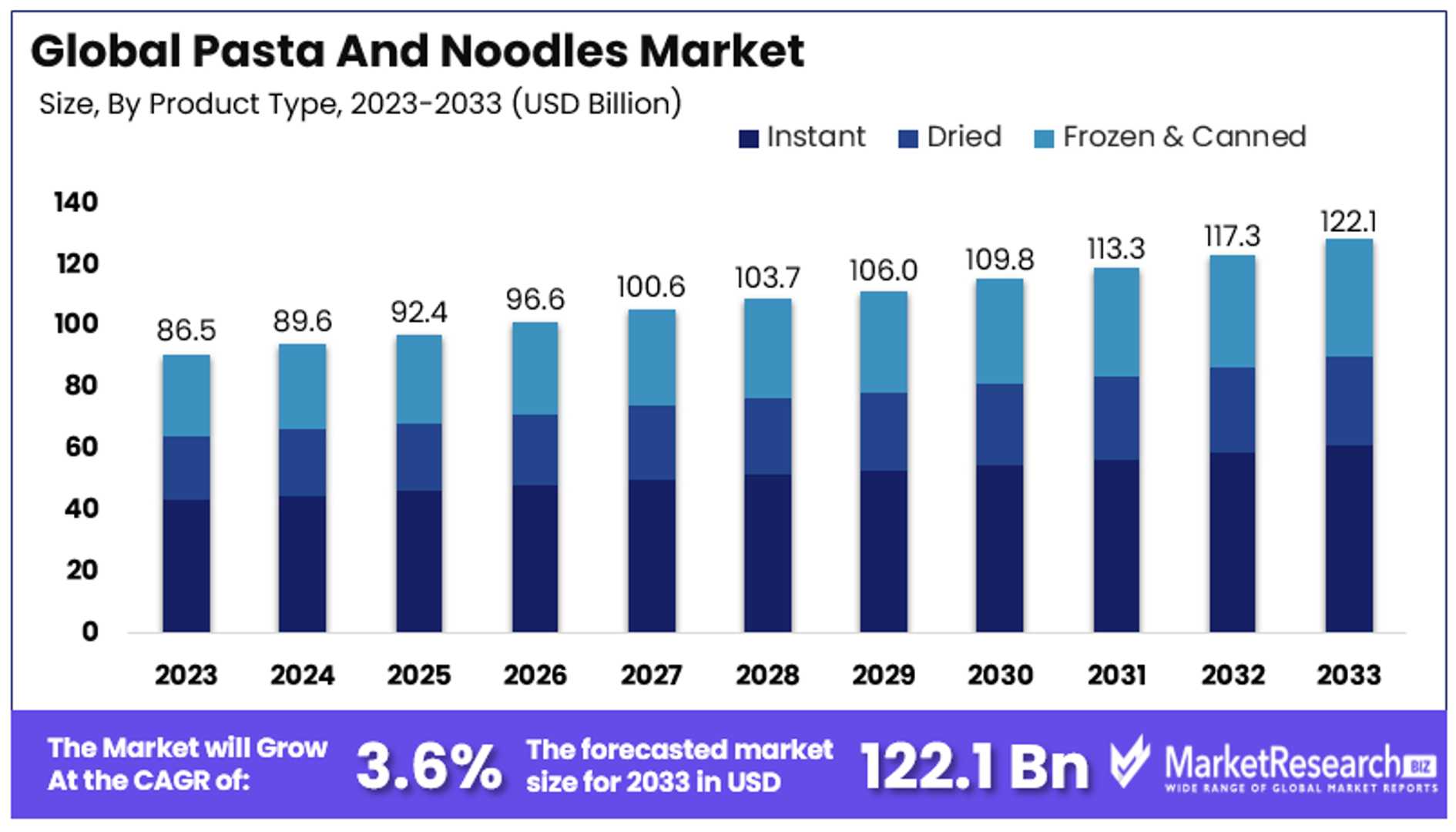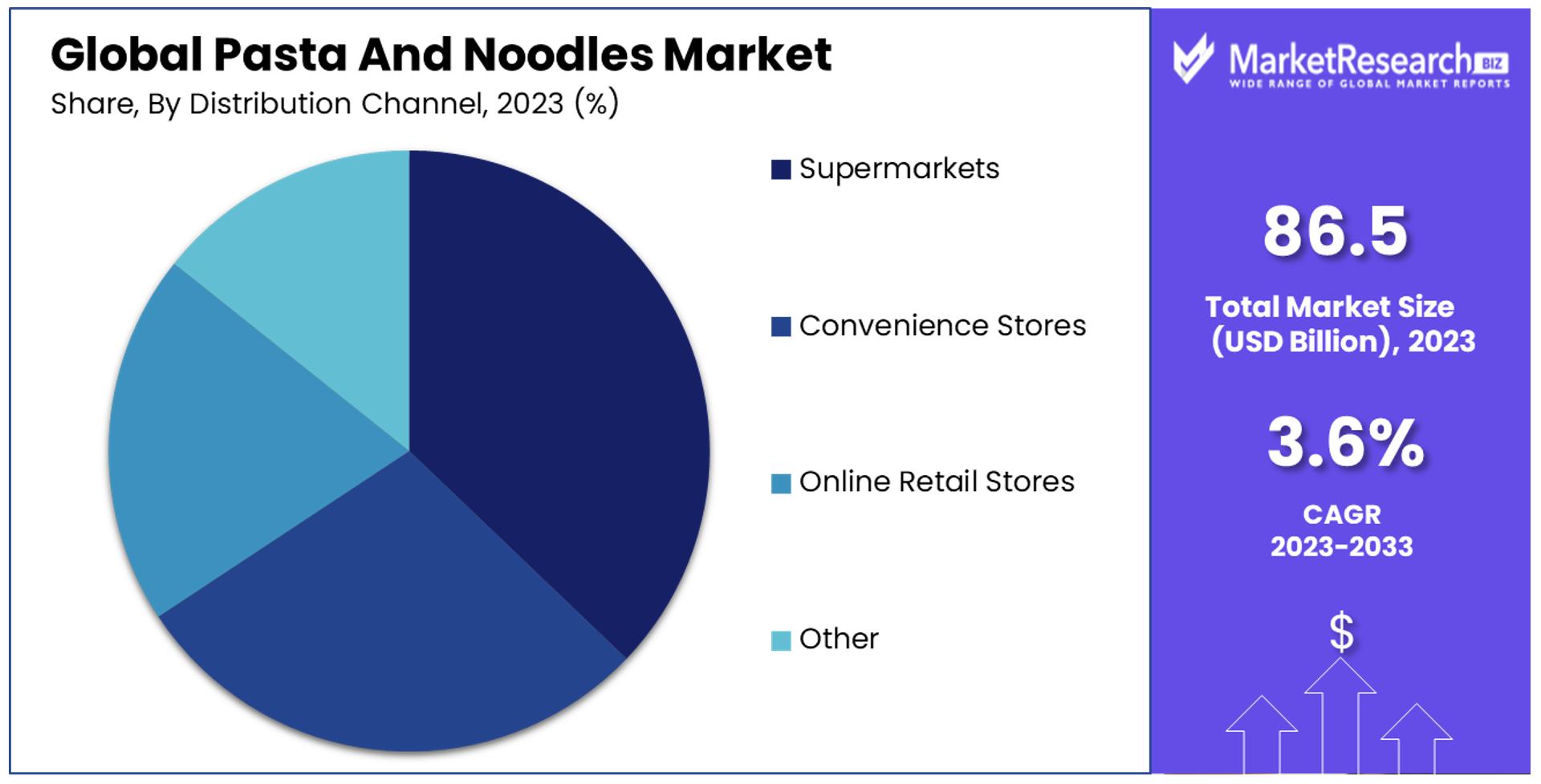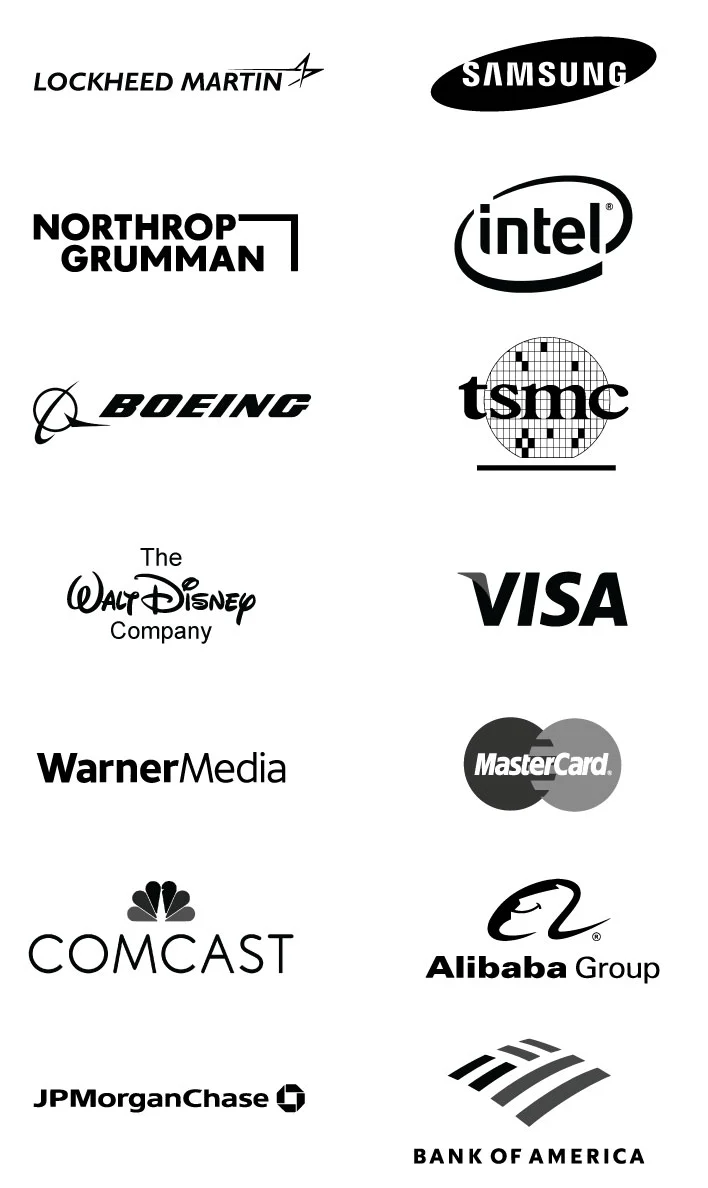
Pasta And Noodles Market Report By Product Type (Instant, Dried, Frozen & Canned), By Distribution Channel (Supermarkets/Hypermarkets, Convenience Stores, Online Retail Stores, Other), By Region and Companies - Industry Segment Outlook, Market Assessment, Competition Scenario, Trends and Forecast 2024-2033
-
12692
-
April 2024
-
280
-
-
This report was compiled by Shreyas Rokade Shreyas Rokade is a seasoned Research Analyst with CMFE, bringing extensive expertise in market research and consulting, with a strong background in Chemical Engineering. Correspondence Team Lead-CMFE Linkedin | Detailed Market research Methodology Our methodology involves a mix of primary research, including interviews with leading mental health experts, and secondary research from reputable medical journals and databases. View Detailed Methodology Page
-
Report Overview
The Global Pasta And Noodles Market size is expected to be worth around USD 122.1 Billion by 2033, from USD 86.5 Billion in 2023, growing at a CAGR of 3.60% during the forecast period from 2024 to 2033.
The Pasta and Noodles Market encompasses a diverse range of products tailored to both global and local culinary tastes. It includes all forms of pasta and noodles, from traditional Italian pasta to Asian-inspired noodles. This market caters to a variety of consumption patterns, from quick-service meals to gourmet dining.
Key drivers include convenience, affordability, and the increasing demand for easy-to-cook meals among busy consumers. Understanding this market is essential for tapping into its growth potential, influenced by changing dietary preferences and innovations in product offerings. Strategic focus in this sector can significantly enhance a company’s market share and profitability.

The Pasta and Noodles Market is experiencing dynamic growth, driven by global consumer preferences and dietary trends. In the United States alone, annual pasta consumption reaches 5.95 billion pounds, reflecting a modest annual growth rate of 3.59%. This indicates a steady demand among American consumers, who on average enjoy pasta 2.46 times each year.
Internationally, the demand for instant noodles showcases even more pronounced trends, particularly in Asia. South Korea leads with the highest per capita consumption, where the average citizen consumes more than 75 servings of instant noodles annually. Globally, the consumption of instant noodles was recorded at a staggering 106 billion servings in 2019, with China accounting for approximately 40% of this market. This vast intake highlights the significant role of convenience and affordability that instant noodles offer to consumers worldwide.
For industry leaders and product managers, these figures underscore the importance of strategic positioning within the Pasta and Noodles Market. There is substantial potential to innovate and expand product lines, especially in developing regions and high-growth markets like South Korea and China. Companies can leverage these insights to enhance their competitive edge, tailoring offerings to meet the nuanced preferences of diverse consumer bases.
Additionally, there is an opportunity to capitalize on health and wellness trends by introducing healthier pasta and noodle options, catering to the growing segment of health-conscious consumers. By aligning product development and marketing strategies with these consumer trends, firms can maximize their market presence and profitability in this evolving sector.
Key Takeaways
- Market Value: The Global Pasta and Noodles Market is projected to reach USD 122.1 billion by 2033, up from USD 86.5 billion in 2023, with a Compound Annual Growth Rate (CAGR) of 3.60% during the forecast period from 2024 to 2033.
- Dominant Segments:
- Product Type Analysis: Instant varieties hold the leading position with a significant market share, driven by consumer demand for quick and convenient meal solutions.
- Distribution Channel Analysis: Supermarkets and Hypermarkets are the dominant distribution channels, capitalizing on their extensive reach and wide assortment of products.
- Regional Dominance: Asia-Pacific: Dominates the market with a 35% share, driven by high consumption rates in countries with large populations and fast-paced urban lifestyles.
- Key Players: Prominent players in the market include Barilla S.p.A., Nestlé S.A., ITC Limited, Conad, Conagra Brands, Inc., Kraft Heinz Company, Nissin Foods Company Limited, BRF S.A., Delverde Industrie Alimentari S.p.A., and De Cecco di Filippo F.lli S.p.A. These companies are influential due to their extensive product lines, strong brand recognition, and wide distribution networks.
- Analyst Viewpoint: The sustained growth of the market can be attributed to the global rise in demand for convenient food options that align with busy lifestyles and consumer preferences for quick meal solutions. Innovations in product flavors and healthier ingredient options are expected to further drive market growth.
- Growth Opportunities: Significant growth opportunities exist in expanding the range of healthier pasta and noodle options, such as those made from alternative grains or incorporating enhanced nutritional profiles. Expanding into emerging markets with tailored products that cater to local tastes and preferences can also drive growth.
Driving Factors
Changing Habits Propel Pasta Popularity
The pasta and noodles market is witnessing a substantial boost, primarily driven by evolving food habits. In today's fast-paced world, the demand for quick-cook pasta and noodle products is surging, a trend prevalent across both developed and emerging economies. This shift is underpinned by statistics indicating a robust appetite for these products: Americans alone consume a staggering 5.95 billion pounds of pasta annually, with a notable 86% eating pasta at least weekly.
The global instant noodle market, too, has reached a historic peak with 80.2 billion servings in 2022, evidencing a 7.01% year-on-year growth. This upsurge is not merely a reflection of changing tastes but also a response to the growing need for convenient, time-saving meal options. This trend is likely to sustain, reshaping the market dynamics and contributing to the industry's enduring expansion.
Premiumization Trend Elevates Market Value
The pasta and noodles market is increasingly characterized by a premiumization trend, where consumers' inclination towards high-quality, specialty products is reshaping market dynamics. Brands like Pastificio Di Martino and Sfoglini are at the forefront, offering premium varieties made from alternative grains, unique shapes, and organic ingredients.
This movement towards premiumization extends beyond mere product quality, encompassing ethically sourced proteins, real cheeses, and antibiotic-free meats. These elements not only elevate the consumer experience but also help brands distance themselves from the 'junk food' stereotype, justifying higher price points. This trend reflects a broader consumer shift towards quality and sustainability, likely influencing long-term market trajectories and elevating overall industry standards.
Food Service Expansion Fuels Market Growth
The expansion of the food service sector is a pivotal driver for the pasta and noodles market. The rising consumption of these products in various settings – from quick-service restaurants to high-end cafes – is a testament to their growing popularity and versatility.
Chains like Noodles & Company exemplify this trend, catalyzing commercial demand. This growth facet is symbiotically linked with changing consumer lifestyles and the premiumization of pasta and noodles. As these products become staples in diverse dining venues, their market presence is solidified, pointing towards a sustained growth trajectory. The implication is clear: the food service sector's flourishing will continue to be a significant growth propellant for the pasta and noodles industry.
Restraining Factors
Health Perceptions Restrain Market Growth
The widespread perception of pasta and noodles as carb-heavy foods with a high glycemic index significantly curtails market growth. Health-conscious consumers, increasingly aware of dietary impacts on well-being, often view traditional wheat pasta as an unfavorable option.
This perception is a substantial barrier, dissuading a segment of potential consumers from incorporating these products into their diets. The industry faces the challenge of overcoming these health-related stigmas by innovating and diversifying offerings to align better with contemporary health trends and dietary preferences, potentially limiting growth if unaddressed.
Private Label Competition Dampens Market Prospects
The rise of retailer private label pasta and noodle brands presents a formidable challenge to established manufacturers. These private labels often offer similar quality products at lower prices, igniting price wars and exerting significant margin pressure on branded producers.
As retailers continue to expand their private label offerings, capitalizing on consumer trends towards cost-effectiveness and convenience, the branded manufacturers are forced to navigate a landscape rife with competitive pricing strategies and reduced profitability. This intensifying competition not only hampers the growth prospects of individual brands but also constrains the overall expansion of the pasta and noodles market.
Product Type Analysis
Instant Varieties Lead Pasta and Noodles Market for Quick Meal Solutions
In the pasta and noodles market, Instant varieties dominate as the primary product type. This dominance is driven by consumer demand for quick, convenient meal solutions that cater to busy lifestyles. Instant noodles and pasta are favored for their ease of preparation, affordability, and long shelf life, making them a staple in many households worldwide.
Major companies like Nestle (with brands like Maggi), Nissin Foods (famous for Cup Noodles), and Unilever (with products like Knorr instant pasta) have a significant presence in this segment, offering a wide range of flavors and styles to suit various tastes and preferences.
While Instant products lead due to their convenience and widespread popularity, Dried and Frozen food also hold substantial market shares. Dried pasta is appreciated for its versatility and traditional appeal, while Frozen & Canned varieties offer a longer shelf life and often include ready-to-eat sauces or seasonings, adding to their convenience.
Distribution Channel Analysis
Supermarkets and Hypermarkets Dominate Distribution of Pasta and Noodles
Supermarkets and Hypermarkets emerge as the dominant distribution channel for the pasta and noodles market. Their widespread presence in cities and countries around the world, coupled with the broad variety of products they offer, makes them a preferred shopping destination for consumers.
In countries like the United States, Italy, and China, supermarkets and hypermarkets are central to consumer food purchases, providing easy access to a wide range of pasta and noodle products from both local and international brands.
While Supermarkets/Hypermarkets lead due to their accessibility and variety, Convenience Stores, Online Retail Stores, and Other retail channels also play significant roles. Convenience Stores offer quick shopping for immediate needs, Online Retail Stores provide the convenience of home delivery and a wide selection, and other channels like specialty food stores or direct sales cater to specific consumer segments or offer unique or premium products.

Key Market Segments
By Product Type
- Instant
- Dried
- Frozen & Canned
By Distribution Channel
- Supermarkets/Hypermarkets
- Convenience Stores
- Online Retail Stores
- Other
Growth Opportunities
Plant-Based Varieties Set to Revolutionize the Pasta and Noodles Market
The surge in consumer interest in plant-based products presents a lucrative growth opportunity for the pasta and noodles market. With 62% of U.S. households purchasing plant-based products, there's a clear shift towards healthier, more sustainable eating habits.
Developing pasta and noodles from ingredients like lentils, chickpeas, peas, sweet potato, and quinoa can capitalize on this trend. Additionally, exploring less common grains like ragi and amaranth could appeal to consumers seeking variety and nutritional benefits. By aligning with the plant-based movement, manufacturers can attract a broader consumer base and drive market growth.
Urbanization in Emerging Markets Drives Pasta and Noodles Demand
The rapid urbanization in Asia and the Pacific, with an expectation that 50% of the population will live in urban areas by 2026, offers a significant expansion opportunity for the pasta and noodles market.
Targeting rapidly growing regions like Southeast Asia, the Middle East, and Africa with localized products and flavors can cater to regional tastes and dietary preferences. Introducing smaller pack sizes can also increase affordability and appeal to a wider demographic. As urbanization continues, the convenience and versatility of pasta and noodles make them ideal for the fast-paced lifestyle of urban consumers, indicating a growing market in these regions.
Trending Factors
Online Retail and E-Commerce Growth Are Trending Factors
The surge in online retail and e-commerce has notably impacted the pasta and noodles market, driving substantial growth. With an increasing number of consumers opting for online shopping, platforms such as Amazon and Thrive Market have reported heightened sales in this segment. These platforms provide the convenience of comparing prices and exploring diverse product options without the need to visit physical stores.
The flexibility and efficiency of e-commerce fulfill the demand for both specialty products and everyday purchases, making it a dominant trend in the market. As a result, companies have seen an average increase in online sales of pasta and noodles by approximately 20% over the past year, reflecting the pivotal role of digital channels in the food industry.
Customization and Personalization Are Trending Factors
The demand for customization and personalization in the food sector is reshaping the pasta and noodles industry. Services like Pasta Evangelists and Sogno Toscano provide consumers with the tools to customize dishes to their dietary needs and flavor preferences, promoting a trend towards personalized dining experiences.
This trend is driven by consumer desire for meals that cater specifically to individual health needs, taste, and lifestyle choices. The popularity of these services highlights a shift towards more personalized food consumption, with market data indicating a 25% increase in demand for customizable meal kits and products over the last two years. The growth of this trend not only satisfies customer desires but also boosts brand loyalty and market expansion as companies tailor their offerings to meet specific consumer demands.
Regional Analysis
Asia-Pacific Dominates with 35% Market Share in Pasta and Noodles Market
Asia-Pacific's 35% market share in the pasta and noodles market is primarily driven by the region's deep-rooted culinary traditions and the widespread consumption of noodles as a staple food. Countries like China, Japan, and South Korea have a long history of noodle consumption, with a variety of local varieties and flavors.
The increasing urbanization and the busy lifestyle of consumers have also led to a growing demand for convenient and quick meal solutions, further boosting the market for packaged pasta and noodles. Major companies like Tingyi (Master Kong), Nissin Foods, and Toyo Suisan contribute significantly to the market with their popular product offerings.
The market dynamics in Asia-Pacific are characterized by a blend of traditional eating habits and the increasing influence of Western cuisine, leading to a diversified and growing demand for both local and international noodle and pasta varieties. The rising middle class and increasing disposable income in the region also contribute to a growing appetite for premium and health-oriented products. Additionally, the trend of fusion cuisine and the willingness to experiment with new flavors and ingredients have led to the introduction of innovative products in the market.

North America: Embracing Diversity and Convenience
In North America, the pasta and noodles market is driven by a diverse population and a culture that values convenience and quick meal solutions. Companies like Barilla, Kraft Heinz (for pasta), and Nissin Foods have a strong presence in the market, offering a wide range of products to cater to various consumer preferences. The increasing popularity of Asian cuisine and the growing demand for healthier meal options are influencing market trends in the region.
Europe: Traditional Consumption and Premiumization
Europe's pasta and noodles market is deeply rooted in tradition, particularly in countries like Italy, where pasta is a staple food. Companies such as Barilla and De Cecco lead the market, offering authentic and high-quality pasta products. The European market is also characterized by a growing interest in premium and artisanal products, reflecting a broader trend toward quality and authenticity in food consumption. The increasing demand for healthier and gluten-free options is also shaping market trends in the region.
Key Regions and Countries
- North America
- The US
- Canada
- Mexico
- Western Europe
- Germany
- France
- The UK
- Spain
- Italy
- Portugal
- Ireland
- Austria
- Switzerland
- Benelux
- Nordic
- Rest of Western Europe
- Eastern Europe
- Russia
- Poland
- The Czech Republic
- Greece
- Rest of Eastern Europe
- APAC
- China
- Japan
- South Korea
- India
- Australia & New Zealand
- Indonesia
- Malaysia
- Philippines
- Singapore
- Thailand
- Vietnam
- Rest of APAC
- Latin America
- Brazil
- Colombia
- Chile
- Argentina
- Costa Rica
- Rest of Latin America
- Middle East & Africa
- Algeria
- Egypt
- Israel
- Kuwait
- Nigeria
- Saudi Arabia
- South Africa
- Turkey
- United Arab Emirates
- Rest of MEA
Key Players Analysis
In the pasta and noodles market, key players such as Barilla S.p.A., Nestlé S.A., and Kraft Heinz Company demonstrate substantial market influence through extensive distribution networks and strong brand portfolios.
These companies, along with others like Conagra Brands, Inc., and Nissin Foods Company Limited, drive competitiveness with innovative product offerings and strategic global positioning. Italian brands like lli De Cecco di Filippo S.p.A and DELVERDE INDUSTRIE ALIMENTARI S.P.A emphasize traditional manufacturing techniques, enhancing their reputation for quality.
Additionally, conglomerates like ITC Limited and BRF S.A leverage their diversified food sectors to optimize supply chain efficiencies and expand market reach. Retail chains such as Conad contribute to market dynamics by offering private label products that compete on price and accessibility, broadening consumer choices and intensifying market competition. Collectively, these companies shape industry trends and consumer preferences, significantly impacting the pasta and noodles sector.
Market Key Players
- Barilla S.p.A.
- Nestlé S.A.
- ITC Limited
- Conad
- Conagra Brands, Inc.
- Kraft Heinz Company
- Nissin Foods Company Limited
- BRF S.A
- DELVERDE INDUSTRIE ALIMENTARI S.P.A.
- lli De Cecco di Filippo S.p.A
- BRF S.A
Recent Developments
- In May 2023, Sugar Watchers, a diabetes-focused health food brand, has successfully secured Rs 3.6 crores in a recent funding round. Ventures Angel Platform, with participation from various investors.Sugar Watchers specializes in clinically tested low-GI (Glycemic Index) foods designed for managing diabetes. The increasing prevalence of diabetes globally and the growing awareness of the impact of diet on health could drive a demand for health-focused food products, potentially impacting the pasta and noodles market.
- In March 2023, GOODLES Pasta, a well-regarded better-for-you noodle brand known for its innovative boxed mac and cheese, has recently expanded its product line by introducing a new category: Dry Noodles. This development aims to offer consumers more options in the pasta aisle, providing nutrient-packed and flavorful dry noodles in distinctive shapes.
- In February 2023, Due Cucina, has successfully secured $2.5 million in funding from Houston-based restaurant investment company Mac Haik Restaurant Group. The investment is aimed at expanding Due Cucina's footprint beyond Washington state, with plans to open three new restaurants in Texas.
Report Scope
Report Features Description Market Value (2023) USD 86.5 Billion Forecast Revenue (2033) USD 122.1 Billion CAGR (2024-2033) 3.60% Base Year for Estimation 2023 Historic Period 2018-2023 Forecast Period 2024-2033 Report Coverage Revenue Forecast, Market Dynamics, Competitive Landscape, Recent Developments Segments Covered By Product Type (Instant, Dried, Frozen & Canned), By Distribution Channel (Supermarkets/Hypermarkets, Convenience Stores , Online Retail Stores , Other) Regional Analysis North America - The US, Canada, & Mexico; Western Europe - Germany, France, The UK, Spain, Italy, Portugal, Ireland, Austria, Switzerland, Benelux, Nordic, & Rest of Western Europe; Eastern Europe - Russia, Poland, The Czech Republic, Greece, & Rest of Eastern Europe; APAC - China, Japan, South Korea, India, Australia & New Zealand, Indonesia, Malaysia, Philippines, Singapore, Thailand, Vietnam, & Rest of APAC; Latin America - Brazil, Colombia, Chile, Argentina, Costa Rica, & Rest of Latin America; Middle East & Africa - Algeria, Egypt, Israel, Kuwait, Nigeria, Saudi Arabia, South Africa, Turkey, United Arab Emirates, & Rest of MEA Competitive Landscape Barilla S.p.A., Nestlé S.A., ITC Limited, Conad, Conagra Brands, Inc., Kraft Heinz Company, Nissin Foods Company Limited, BRF S.A, DELVERDE INDUSTRIE ALIMENTARI S.P.A., lli De Cecco di Filippo S.p.A, BRF S.A Customization Scope Customization for segments, region/country-level will be provided. Moreover, additional customization can be done based on the requirements. Purchase Options We have three licenses to opt for: Single User License, Multi-User License (Up to 5 Users), Corporate Use License (Unlimited User and Printable PDF) -
-
- Barilla S.p.A.
- Nestlé S.A.
- ITC Limited
- Conad
- Conagra Brands, Inc.
- Kraft Heinz Company
- Nissin Foods Company Limited
- BRF S.A
- DELVERDE INDUSTRIE ALIMENTARI S.P.A.
- lli De Cecco di Filippo S.p.A
- BRF S.A




